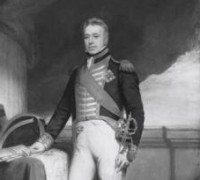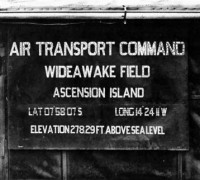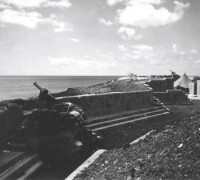ASCENSION ISLAND AND THE SECOND WORLD WAR - ASCENSION ISLAND IN THE WAR
5)SUMMER OF 1943
BY DAVID FONTAINE MITCHELL
The summer of 1943 also witnessed increased submarine activity within the vicinity of the island, prompting the 30 September formation of a U.S. Navy squadron tasked with conducting anti-submarine patrols in PB4Y-1s. On 1 October the USS Milwaukee and the USS Moffett arrived with 28 U.S. Navy personnel to assist the newly formed squadron. The Navy pilots engaged in multiple operations throughout the fall season and into 1944, locating and sinking several U-boats maneuvering in the South Atlantic. They were assisted in their efforts by the HF/DF station that was working in conjunction with St. Helena and Freetown. The target reports that were quickly issued by the station provided the pilots with pin point enemy U-boat locations, resulting in several successful missions.
October 1943 was a rough month for those stationed on Ascension, as three plane crashes occurred around the island resulting in the death of 16 men. Three bodies were recovered at sea and subsequently buried at the U.S. cemetery that had been established a year earlier in an area of the island known as “Two Boats.” The worst crash on the island occurred less than two years later when, on the morning of 10 May 1945, a Douglas C-58B landed prematurely.
The aircraft exploded shortly after impact, killing 12 passengers and injuring the other six people on board. In total, more than 60 men died serving on or around Ascension during the war. Many of these deaths occurred when planes crashed while arriving at or departing from the island. Thirty-six Americans were buried at the U.S. cemetery prior to the February 1947 repatriation of their bodies to Fort Buchanan, Puerto Rico.
On 11 December, the USS Monterey arrived on the island with more reliefs; 183 servicemen of the 895th Engineer Aviation Company, 26 men of the Signal Corps, and 56 Navy personnel arrived to relieve members of the 898th and the naval detachment. During the entire year of 1943, Wideawake Field received 4,779 tactical planes (3,595 U.S. and 1,184 RAF) and 2,156 cargo planes (1,984 U.S. and 172 RAF) while accommodating a total of 59,399 transit personnel. The total fuel consumption for the year was 8,467,195 gallons. Several of the island’s facilities that had previously been made up of fabricated tents and huts were replaced by sturdier buildings of timber or brick and many new roads were asphalted. An additional water distillation unit was also installed on the island, allowing the daily ration to be increased to eight gallons per man per day.
January 1944 witnessed another milestone for the island’s airfield as a record-setting 98 planes were received in one day, on the 25th. The Allies had landed in Anzio, Italy, on 22 January and several of these aircraft were on their way to assist with the ongoing operation. One month later, on 26 February, the 898th Engineers departed Ascension for the Pacific Theater on the SS State of Maryland, accompanied by the Omaha. By the spring, over 1,000 planes were stopping to refuel on Ascension each month. Fifty St. Helenians were transported to the island on 11 March to assist with ongoing U.S. military projects. Much like the British would contract work out to Africans, U.S. forces began to hire St. Helenians for similar purposes. One of the projects consisted of laying a new 2,350foot replacement submarine pipe to link the fuel tanks to the tankers offshore.
This pipe line was established on 20 March in similar fashion to the one constructed roughly two years earlier. In order to pass the time, the Americans established a nine-hole golf course, a baseball field, a volleyball court, an area for horse-shoe throwing, and an outdoor theatre. The theatre became known as the “Bull Gang Theatre” and was later expanded to host live United Service Organizations (USO) entertainment events on the island. Some of the entertainment involved nightly movie screenings and occasional game and party nights. An Anglican church known as “St. Mary’s” had been on Ascension since the early 1840s, providing a place of worship for Protestants stationed on the island, and in April 1944 Catholics got their own place of worship when the 895th Engineers erected a Roman Catholic chapel known as “The Grotto.”
The island experienced a setback on 22 April when the USAT Gatun, a U.S. ship carrying fuel and supplies, caught fire while in Recife Harbor en route to Ascension. Everything on the ship was destroyed, forcing Ascension to temporarily ration supplies and call for emergency fuel. Water also had to be rationed to 3.5 gallons per person, as fuel was needed in order to run the distillation units. Given that only 15 days’ worth of fuel remained on the island, a tanker needed to arrive quickly. The call was answered on 5 May with the arrival of the DE 176 USS Micka with emergency fuel supplies. However, the situation remained critical until further fuel and supply transports arrived later in the month on 21 and 26 May.
In contrast to the earlier buildup of troop levels on Ascension, the spring of 1944 brought an overall decrease in the number of servicemen assigned there. The 426th Coast Artillery received their orders to return to the States on 22 March and 18 of the island’s fighter pilots were transferred out on the 27th, leaving only two with the squadron. On 3 April the Monterey returned to Ascension accompanied by the USS Cannon and the Brazilian destroyer Marcilio Dias. The Monterey was to transport the 48 men of the 28th Coast Artillery and roughly 450 other servicemen off the island. The 28th was later inactivated on 5 October, and its members were reassigned to separate Army units stationed on the island. On 14 April the Monterey departed for Recife, escorted by the USS Christopher.
The island’s leadership also underwent changes throughout the spring and summer. On 19 April Col. A.J. Ronin replaced Col. Mullenix as commander of U.S. forces on the island. Brig. Gen. Ralph H. Wooten assumed command of the South Atlantic Command on 19 May, taking over from Maj. Gen. Walsh. Wooten would first visit Ascension with his staff on 23 July. Capt. Caldwell gave up his oversight of C&W on 14 June, transferring command of the AVDF to R.W.C. Byme, who was subsequently promoted from sergeant to captain. Just over three months later, on 26 September, Mr. Maurice Campbell Clarke was sworn in as resident magistrate. By the end of June there were roughly 1,400 servicemen left on the island. Enemy U-boat activity in the area was at its lowest since the war began. The 10 July return of the Monterey escorted by the Marcilio Dias brought 600 U.S. personnel to relieve those stationed on the island. The ships departed four days later with roughly 400 servicemen on board.
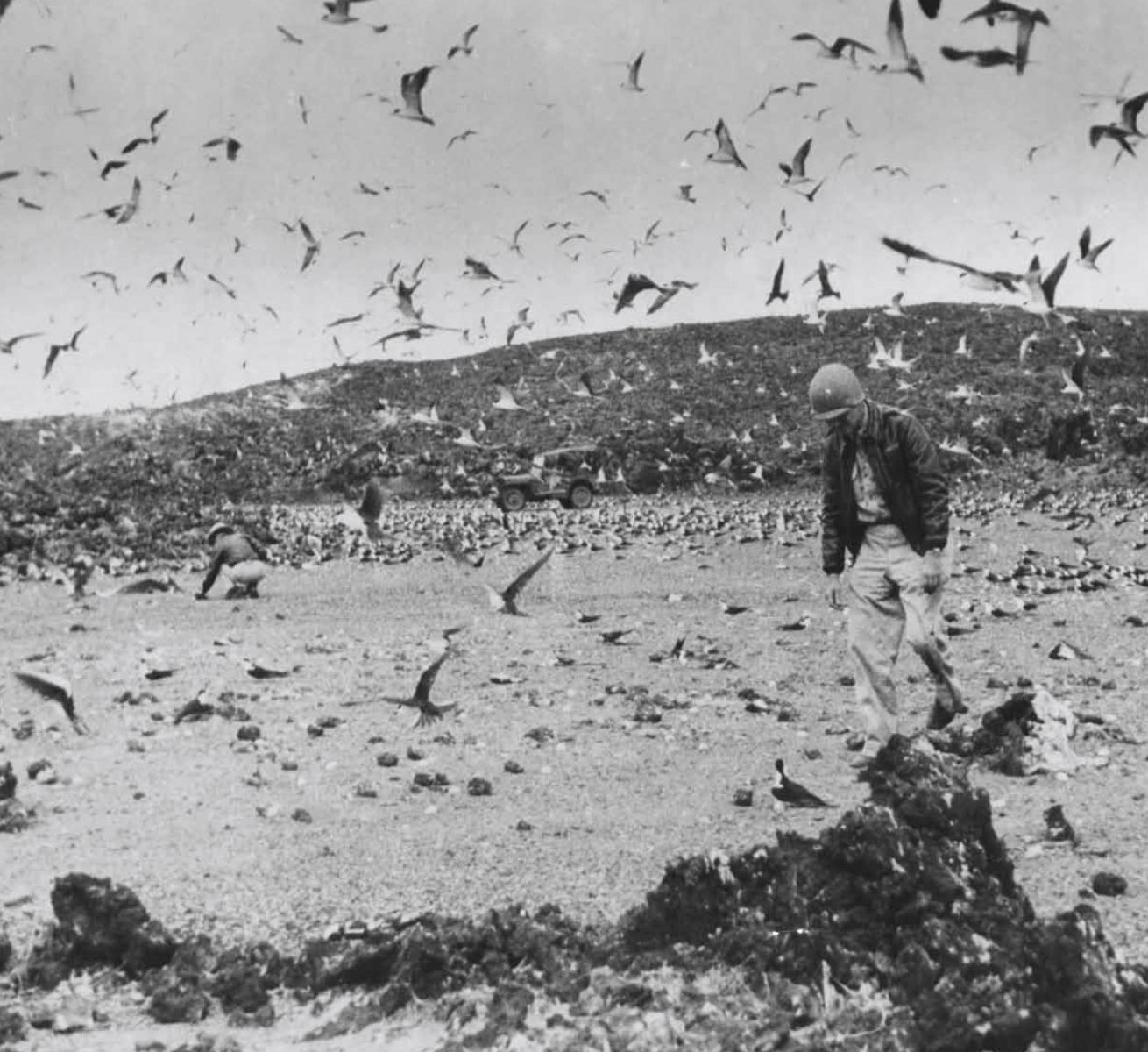
Nesting grounds of the Wideawake birds. The National Archives
The island’s first radio station, “WXLR,” became operational on 13 September, broadcasting within a 40-mile radius. The station would transmit news to the troops for four hours per day through the roughly 300 receiving sets that were located on the island. Also, following the Gatun incident earlier in the year, construction on two new 420,000-gallon fuel tanks to serve as emergency backups began at the end of September. This project was completed and fully operational by the end of December. The Monterey arrived again on 17 October, this time escorted by the Christopher and bringing 382 replacements for U.S. servicemen. The ships departed four days later with 495 relieved personnel, lowering the total number of U.S. servicemen on the island. By the end of the year, there were 82 U.S. Navy personnel, 1,362 U.S. Army personnel, 43 Royal Navy personnel, 18 Royal Air Force personnel, 31 C&W workers, and 81 St. Helenians, for a total of 1,617 people on the island. Further strength reductions would come over the next year as the war came to a close.
Soldiers on Ascension, under the direction of an American civilian consultant named Kendrick W. Blodgett, constructed a hydroponics farm known as “Hydroponics Station No. 1 Laboratory” in January of 1945. The farm was such a remarkable achievement that it received coverage in a 1945 issue of National Geographic Magazine. The Engineers were able to carve out an area of roughly 80,000 square feet and convert it from rough, barren volcanic terrain into lush vegetation. The farm grew several fresh vegetables, including lettuce, tomatoes, and cucumbers. Given the isolated location of Ascension, the importation of fresh vegetables was nearly impossible at the time; before the hydroponics farm was operational, the men lived off of canned and frozen food rations, fish, and occasional fruit brought in from Brazil, West Africa, and South Africa. A pre-existent small farm on Green Mountain produced a limited supply of vegetables, but nothing like the hydroponics station achieved. Later in the year, on 31 March, a hive of bees was transported from the U.S. to the island in hopes of assisting with the fertilization process. The Ascension station was the USAAF’s first large-scale testing center of the hydroponics method, and it proved mightily successful. By the springtime, everyone on the island was receiving fresh vegetable rations two times per week, a marked increase from the past.
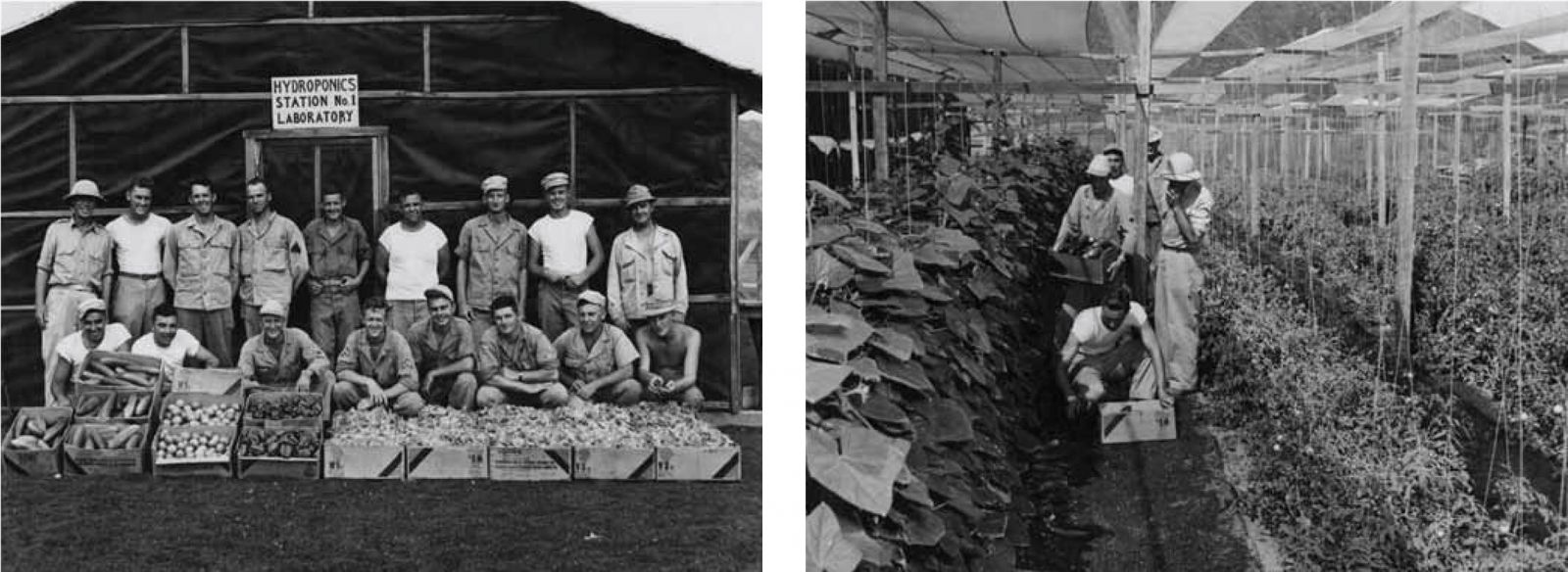
The hydroponics garden. The National Archives. The hydroponics garden. The National Archives.
Cont.
